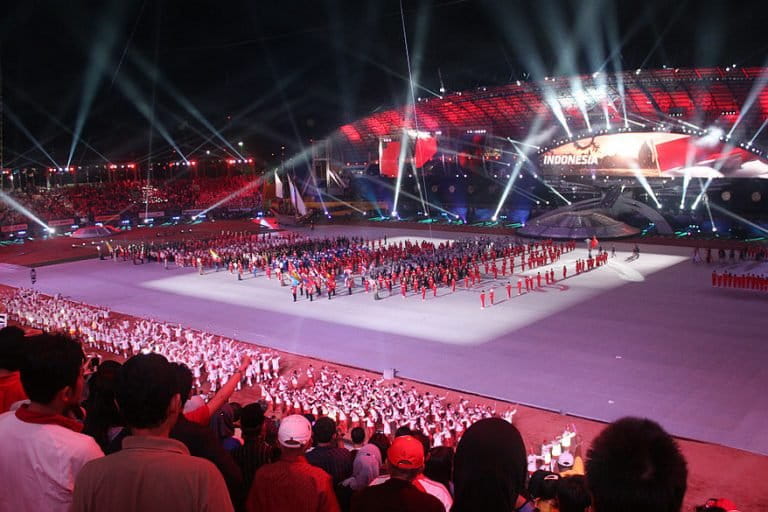- Fires have started to flare up in Indonesia’s South Sumatra province, which will co-host thousands of athletes, officials and visitors for the Asian Games, the continent’s biggest sporting event, later this month.
- Officials are worried about a repeat of the devastating 2015 fires that burned up an area three times the size of the state of Delaware, and that generated haze that sickened half a million people.
- After relatively mild fire seasons in 2016 and 2017, thanks to longer rainy spells, dry conditions are expected to intensify this year, at least through September, raising the risk of more fires and possibly haze.
JAKARTA — The threat of haze from another season of forest fires on Indonesia’s Sumatra Island hangs over Asia’s biggest sporting event, scheduled to kick off later this month.
Authorities in South Sumatra province detected 198 fire hotspots across the province in July, most of them in districts with a long history forest fires. These include the districts of Ogan Komering Ilir and Ogan Ilir, both close to the provincial capital, Palembang, which is co-hosting this year’s Asian Games. Tens of thousands of athletes, officials and visitors from 45 countries are expected to attend the Games, which Jakarta is also co-hosting.
The Indonesian government is keen to avoid a repeat of the 2015 burning season, when unusually dry conditions combined with the tinderbox nature of peatlands that had been drained for planting, to fuel massive fires. An estimated 20,000 square kilometers (7,700 square miles) of land, an area three times the size of Delaware, went up in flames. The burning generated a choking haze that sickened half a million people in Indonesia alone, and spread into neighboring countries.
Najib Asmani, a special adviser on climate change to the South Sumatra governor, blamed this year’s fires on residents continuing to practice slash-and-burn forest clearing as a cheap way of preparing land for agriculture.
“The most effective way [to prevent forest fires] is to prevent people from burning the land,” he told Mongabay Indonesia. “We’re dealing with people here. They might already know [that burning is wrong], but they still have many reasons to do it.”
He said fire-prevention initiatives launched in the wake of the 2015 disaster, including restoring degraded peatland and raising awareness at the village level, hadn’t been fully implemented across all areas of South Sumatra.
Hairul Sobri, director of the South Sumatra chapter of the Indonesian Forum for the Environment (Walhi), said the government’s tendency to blame local farmers for the forest fires was an “outdated way of thinking.” Instead, large plantation companies should be held accountable, he said.
“Most of the forest fire monitoring should be aimed toward land-hungry companies, because to date, most of the fire spots are on peatland that fall within these companies’ concessions,” he said in a press release.
And even if those fires are started by outsiders and not the companies, the latter are still to blame for failing to prevent the encroachment by locals onto their land, Hairul said.
He cited the case of a fire in a concession held by a plantation company in Cinta Jaya village, Ogan Komering Ilir district, in July. In that incident, he said, police found the company to be negligent — regardless of who started the fire — because a monitoring tower that it was required to build was not ideally located to survey the entire location and spot the fire in time. Police also said the company did not have firefighting equipment in place before the blaze broke out, and only brought it in afterward.

Dry season alert
The devastating fire season of 2015 was followed by two years of longer rainy seasons, which helped keep the number of hotspots down and fires from spreading extensively. This year, however, is expected to witness a normal dry season, with no rain at hand.
Experts have predicted forest fires to return in full force, particularly in areas including South Sumatra, which has a long history of fire episodes.
Dasrul Chaniago, the director of air pollution control at the Ministry of Environment and Forestry, said the government would be pushed hard this year to keep air quality healthy enough for locals, athletes and visitors to breathe.
“This year, one of the toughest challenges is to keep peatland and forests from burning,” he said at a recent discussion on air pollution in Jakarta. “We will experience the hottest weather in August and September.”
Palembang has so far remained free of haze, but the threat is ever-present, as the dry season intensifies through September. The prospect of a repeat of the 2015 disaster has spurred the government to enlist the military in firefighting efforts; hundreds of soldiers have been deployed to monitor 55 villages in Ogan Komering Ilir and Ogan Ilir districts alone.
The National Police chief, Tito Karnavian, has also called for greater vigilance against forest burning. Fires and the haze they generate will not just harm locals and the environment, he said, but also reflect badly on Indonesia, “especially now that South Sumatra is hosting the Asian Games.”
Najib said that while the government was doing all it could to ensure a haze-free event, by involving all stakeholders and campaigning against slash-and-burn forest clearing, fire hotspots kept flaring up in the province.
“We can only hope that God opens the hearts of the perpetrators [of the fires] so that the fires can soon stop,” he said.
Banner image: A peat swamp in Sumatra smolders during the 2015 haze crisis. Image by Rhett A. Butler/Mongabay.














